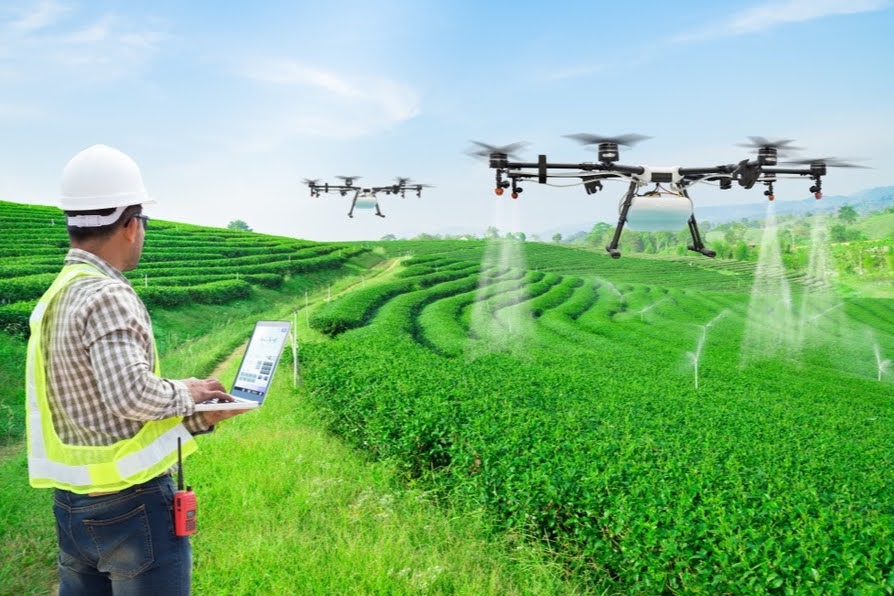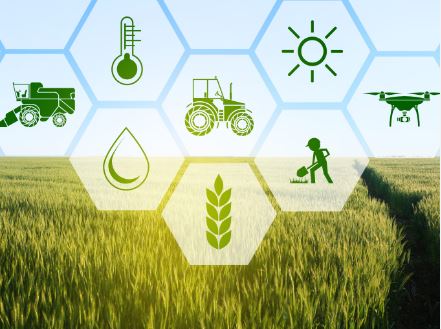
AI continues to advance, its potential in agriculture becomes even more promising. From autonomous drones
for crop monitoring to robotic pollinators for enhancing crop yield, the possibilities are limitless. However, the widespread adoption of AI in agriculture requires collaboration between technology providers, policymakers, and farmers. Access to affordable technology, data privacy and security, and robust infrastructure are key factors in ensuring the equitable distribution and successful implementation of AI-driven solutions.
Introduction
In the realm of agriculture, the incorporation of artificial intelligence (AI) has emerged as a transformative force, reshaping conventional farming practices and propelling the agricultural industry into a new era. Through the utilization of advanced technologies and machine learning algorithms, AI holds immense potential to optimize crop production, enhance resource management, and vastly improve overall efficiency within the agricultural sector. This comprehensive article delves deep into the multifaceted applications of artificial intelligence in agriculture, exploring how this disruptive technology is revolutionizing the cultivation of crops, management of livestock, and the imperative task of addressing global food security challenges.
The Role of AI in Agriculture
AI has emerged as a game-changer in agriculture, empowering farmers with real-time insights and
data-driven solutions. With its ability to analyze vast amounts of agricultural data, AI enables precise decision-making and enhances overall productivity. With its unparalleled capacity to process vast quantities of data and derive actionable insights, AI empowers farmers to make informed decisions based on concrete evidence, thereby maximizing their yields while minimizing resource consumption.
Let us delve into the diverse facets of AI in agriculture that underpin this profound transformation:
AI-Driven Precision Farming

Remote Sensing and Imaging Technologies
One of the key applications of AI in agriculture is remote sensing and imaging technologies.
By leveraging drones, satellites, and sensors, farmers can gather valuable information about
their crops, including plant health, growth patterns, and stress factors. AI algorithms process this data to provide actionable insights for optimized farming practices.
Crop Monitoring and Disease Detection
AI-powered systems can monitor crops and identify signs of diseases or nutrient deficiencies.
By analyzing images and data collected from sensors, AI algorithms can detect anomalies in
plant health and provide timely recommendations for corrective actions. This proactive approach helps farmers prevent yield losses and ensure healthy harvests.
Irrigation and Water Management
Water scarcity is a pressing challenge in agriculture. AI offers intelligent irrigation systems that optimize water usage based on crop needs, weather conditions, and soil moisture levels. By precisely delivering water where and when it’s needed, AI-driven irrigation systems conserve resources and improve crop health.
Predictive Analytics for Yield Optimization
AI algorithms can analyze historical data, weather patterns, and other variables to predict crop yields accurately. By understanding the complex interplay of factors, farmers can make data-driven decisions to optimize yield, manage resources efficiently, and maximize profits.
AI-Enabled Crop Protection
Pest and Weed Detection
AI-based solutions enable early detection of pests and weeds, helping farmers take proactive measures to protect their crops. Through image recognition and machine learning algorithms, AI systems can identify and differentiate between pests, diseases, and beneficial insects, aiding targeted pest control strategies.
Automated Pest Control
AI-powered robotics and automation technologies offer innovative solutions for pest control. Autonomous drones and robots equipped with spraying mechanisms can precisely target affected areas, reducing the need for chemical treatments and minimizing environmental impact.
AI-Enhanced Supply Chain Management
Inventory and Demand Forecasting
AI algorithms can analyze market trends, historical data, and consumer preferences to forecast demand accurately. This helps farmers optimize their inventory levels, plan production cycles, and meet market demands efficiently.
Quality Control and Sorting
AI-powered systems can inspect and sort harvested produce based on quality parameters such as size, shape, color, and ripeness. This automated process ensures consistent product quality and minimizes waste.
Harvesting and Sorting Robots
AI-driven robotic systems are transforming the harvesting process. These robots can autonomously harvest crops while identifying and sorting them based on quality standards. This technology reduces labor costs, increases harvesting efficiency, and improves overall productivity.
AI for Soil Health and Nutrient Management

Soil Monitoring and Analysis
AI enables real-time monitoring of soil conditions, including nutrient levels, pH balance, and moisture content. With this information, farmers can apply precise amounts of fertilizers and amendments, optimizing soil health and nutrient management.
Nutrient Optimization
AI algorithms can analyze soil and crop data to recommend the ideal balance of nutrients for specific crops. By tailoring fertilizer applications to meet the precise requirements of each plant, farmers can minimize waste, reduce environmental impact, and improve crop health.
Challenges and Limitations of AI in Agriculture
While AI holds immense potential for revolutionizing agriculture, it also faces challenges. These include the need for reliable data, high implementation costs, and limited access to technology in rural areas. Addressing these issues will be crucial to realizing the full benefits of AI in agriculture.
How AI should be combined with other technologies
As we are aware that AI can not function efficiently without Big data, sensors and supported software.
In the same way, other tools can’t work without AI. To make AI technology work, it’s also important to have good data engineers and data scientists. Let us explore about how artificial intelligence with other technologies can be used in farming.

Big data for informed decision-making
The real reason for making and gathering data is to use it. Data analytics can help farmers make huge gains in output and save a lot of money. When AI and big data are used together, farmers can get good advice based on well-organized, real-time data about what their crops need. This will take away the need to guess and allow farmers to be more precise with things like watering, fertilizing, protecting crops, and reaping..
IoT sensors for capturing and analyzing data
IoT sensors, drones, GIS, and other software can enable farmers to monitor, measure and record field data in real-time. By putting IoT devices and software together with AI farming tools, farmers can get more accurate information faster. With the help of more information, they can make better choices and spend less time and money
Automation and robotics for minimizing manual work
AI, self-driving tractors, and the Internet of Things (IoT) can be a efficient solution for the common problems in farming. These technologies could also save money because they are more reliable and make fewer mistakes. We can maximize the benefits by using AI, self-driving tractors, and the Internet of Things (IoT).
Robotics is a tool that isn’t used as much but is growing quickly. Robots are already being used in agriculture to do manual tasks like picking fruits and veggies and thinning lettuce.
There are a lot of ways that robots are better than farm humans.
Reality vs. hopes for artificial intelligence in farming that is reliable
There is no doubt that AI helps farmers in many ways. With the help of smart farming tools and vertical farming systems we can automate the repetitive tasks. This frees up farm workers to do more important tasks that require human intelligence. It is crucial to acknowledge that the implementation of AI cannot be accomplished through a simple purchase and activation process akin to that of a mechanical device. Artificial Intelligence is an intangible concept that cannot be physically grasped. This refers to a set of programmable technologies capable of autonomous operation.
Artificial intelligence is basically a copy of how people think. It uses data to learn and solve problems.
As AI can cannot do the things on it’s own, farmers need a technology base before they can get all the benefits of AI. Building that infrastructure will take some time, But if farmers do this, they will be able to build a strong technology community that will last.
For now, companies that make technology need to think about a few things: how to improve their tools, how to help farmers deal with their problems, and how to make it clear that machine learning helps solve real problems, like making less physical work necessary. AI’s future in farming is sure to be successful.
used for manual work, like picking fruits and veggies and thinning lettuce. There are a lot of ways that robots are better than farm humans. They can work for longer, are more accurate, and make fewer mistakes.
Future Prospects

As AI continues to advance, its potential in agriculture becomes even more promising. From autonomous drones for crop monitoring to robotic pollinators for enhancing crop yield, the possibilities are limitless. However, the widespread adoption of AI in agriculture requires collaboration between technology providers, policymakers, and farmers. Access to affordable technology, data privacy and security, and robust infrastructure are key factors in ensuring the equitable distribution and successful implementation of AI-driven solutions.
Conclusion
Artificial intelligence is revolutionizing the landscape of agriculture by providing farmers with powerful
tools to optimize crop management, increase yields, and effectively address global food security challenges.
From precision agriculture and crop surveillance to automated irrigation systems and predictive analytics,
AI heralds a transformative era for the farming community. As this remarkable technology continues to advance, it holds immense potential to usher in a new era characterized by sustainable, efficient, and intelligent farming practices. By wholeheartedly embracing AI in agriculture, farmers can maximize their productivity, minimize environmental impact, and contribute significantly to a future where food security is assured.
FAQs
How has AI affected agriculture?
Farmers can better monitor crops and change water input or canopies to events like California’s rainstorms or dry conditions with AI.
What problems can AI solve in agriculture?
1.Precision Farming
2.Disease detection
3.Weather & price Forecasting
4.Health Monitoring of Crops
5.Agriculture Robotics
How does AI benefit farmers in agriculture?
AI provides real-time insights, improves decision-making, and optimizes crop yields.
Can AI help in reducing water usage?
Yes, AI enables precise irrigation systems that conserve water by delivering it where and when it’s needed.
How does AI assist in pest control?
AI enables early pest detection and offers robotic solutions for targeted pest control, reducing the reliance on chemical treatments.
What is the role of AI in supply chain management?
AI enhances inventory forecasting, quality control, and sorting processes, improving overall supply chain efficiency.
Will AI contribute to sustainable agriculture practices?
Yes, AI-driven precision farming, crop protection, and soil health management promote sustainability in agriculture.
How can artificial intelligence monitor crop and soil?
With the help of sensors and machine learning algorithms.
How AI is transforming agriculture?
By using precision agriculture, systems can improve the overall harvest quality and accuracy.
What are the main problems AI can solve?
1.Agriculture
2.Healthcare
3.Wildlife Conservation
4.Learning and Training
5.Transportation
6.Hiring
How is agriculture field benefiting from AI?
AI software helps in identifying pest attacks and plant health problems.
What is the scope of AI in agriculture?
AI-based technological solutions have helped farmers produce more with less input, enhance output quality, and speed crop go-to-market.
Can AI be used for disease detection in crops?
Yes
What is expected growth in agriculture?
It is estimated to grow from $1 billion to $4 billion from 2020 to 2026, attaining a CAGR of 25.5%.
When was AI introduced in agriculture?
In 1985, McKinion and Lemmon tried to use AI in agriculture for the first time by making GOSSYM, a cotton crop simulation model that used Expert System to improve cotton production based on irrigation, fertilization, weed control-cultivation, climate, and other factors.
How robots are used in agriculture?
Robots can do a lot of different things, like keeping an eye on crops and measuring the PH level of the soil to simple tasks like picking and packing fruits and vegetables and planting seeds.
Can AI replace human intelligence?
No. While AI can replace some tasks, it cannot replace human problem-solving skills.
